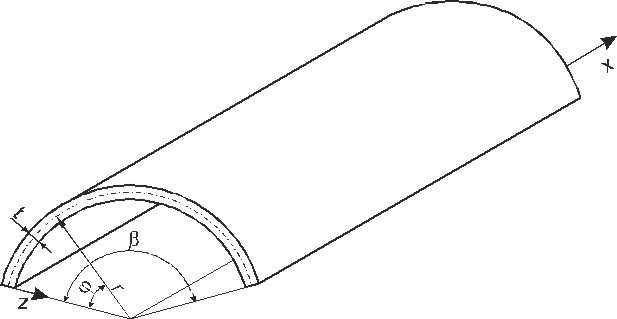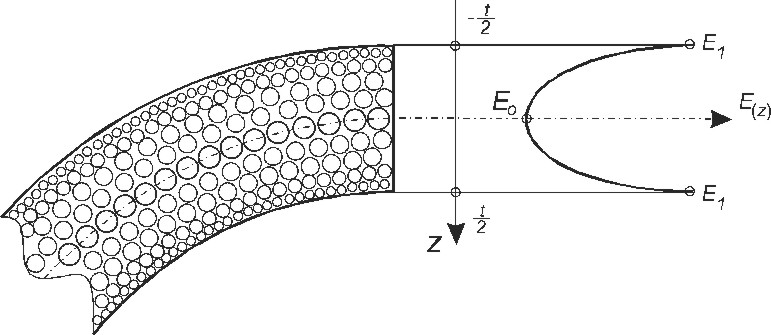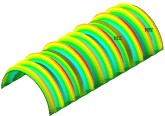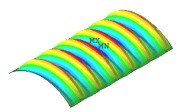
engineering & technology publications
ISSN 1759-3433
PROCEEDINGS OF THE TENTH INTERNATIONAL CONFERENCE ON CIVIL, STRUCTURAL AND ENVIRONMENTAL ENGINEERING COMPUTING
Buckling of an Isotropic Porous Cylindrical Shell
+Institute of Mechanical Engineering and Machine Operation, University of Zielona Góra, Poland
*Institute of Applied Mechanics, Poznan University of Technology, Poland
A general overview of modelling and stability of sandwich structures is presented in survey paper [2]. The material model used in the current paper is as described in references [3,4]. The basic assumption of porosity varying in the transverse direction is defined as
| (6) |
where
A non-linear hypothesis of the deformation of a plane cross section of the shell is
assumed. The geometric and physical relationships (according to Hooke's law) are
linear. The above stated problem gives the system of differential equations and
boundary conditions written in a cylindrical coordinates system. In a second step,
basic equations of elastic buckling of an isotropic porous shell are obtained. They
are formulated on the grounds of the principle of stationary total potential
energy of the compressed shell,
![]() , where
, where
![]() is the energy of elastic strain
and
is the energy of elastic strain
and ![]() is the work of load. A simply supported cylindrical porous panel carries a
uniformly distributed axial load of intensity
is the work of load. A simply supported cylindrical porous panel carries a
uniformly distributed axial load of intensity ![]() over its span
over its span ![]() (the length of
the curve). In a particular case a shell is made of an isotropic non-porous material,
and the elasticity coefficient does not depend on the coordinate
(the length of
the curve). In a particular case a shell is made of an isotropic non-porous material,
and the elasticity coefficient does not depend on the coordinate ![]()
![]() . In this case
a Lorenz-Timoshenko-Southwell formula of the following form was obtained:
. In this case
a Lorenz-Timoshenko-Southwell formula of the following form was obtained:
![]() .
.
In addition to analytical treatment, the problem was also analyzed using the FEM
method by means of the ANSYS computer system. Some graphical outputfrom this system is shown in
Figure 53.3. The analytical and
numerical analyses were carried out for following porous shells: Young's modulus
.
.
In addition to analytical treatment, the problem was also analyzed using the FEM
method by means of the ANSYS computer system. Some graphical outputfrom this system is shown in
Figure 53.3. The analytical and
numerical analyses were carried out for following porous shells: Young's modulus
![]() MPa,
MPa, ![]() MPa,
MPa,
![]() MPa and
MPa and
![]() MPa,
MPa, ![]() and suitably
and suitably ![]() ,
, ![]() ,
, ![]() . The material properties varying
through the thickness of the cross-section were discretized with 41 layers of constant
properties.
. The material properties varying
through the thickness of the cross-section were discretized with 41 layers of constant
properties.
The FEM critical parameter values
![]() for a family of shells
for a family of shells
![]() are
3.5% smaller than values obtained by means of the analytical solution. Comparison of
analytical solution with the FE results and Lorenz-Timoshenko-Southwell formula
are
3.5% smaller than values obtained by means of the analytical solution. Comparison of
analytical solution with the FE results and Lorenz-Timoshenko-Southwell formula
![]() shows that the error is within the range +8.6% and -0.4%.
shows that the error is within the range +8.6% and -0.4%.
- 1
- J. Banhart, "Manufacture, characterisation and application of cellular metals and metal foams", Progress in Materials Science, 46, 559-632, 2001. doi:10.1016/S0079-6425(00)00002-5
- 2
- L. Librescu, T. Hause, "Recent developments in the modelling and behaviour of advanced sandwich constructions: a survey", Composite Structures, 48, 1-17, 2000. doi:10.1016/S0263-8223(99)00068-9
- 3
- K. Magnucki, P. Stasiewicz, "Elastic bending of an isotropic porous beam", Int. Journal of Applied Mechanics and Engineering, 9(2), 351-360, 2004.
- 4
- K. Magnucki, P. Stasiewicz, "Elastic buckling of a porous beam", Journal of Theoretical and Applied Mechanics, 42(4), 859-868, 2004.
- 5
- J. Mielniczuk, "Plasticity of porous materials. Theory and the limit load capacity", Publishers of Poznan University of Technology, Poznan (in Polish), 2000.
purchase the full-text of this paper (price £20)
go to the previous paper
go to the next paper
return to the table of contents
return to the book description
purchase this book (price £135 +P&P)




